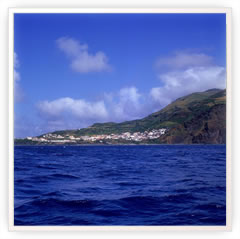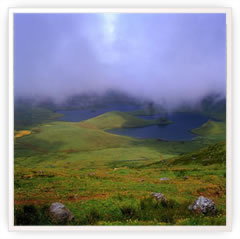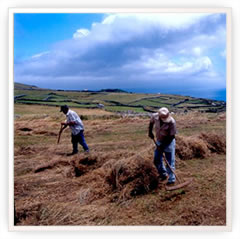Corvo Island




HISTORY
The date of the discovery of the islands of Flores and Corvo is a matter of some controversy, although it is known that it took place later than that of the other seven islands in the Azores. It is said, however, that it was sighted in 1452 by Diogo de Teive and his son. Initially called the Island of São Tomás or Santa Iria, the name was soon changed to Flores (Flowers), due to the abundance of yellow flowers (goldenrod) that covered the entire island and whose seeds may have been brought from the peninsula of Florida, in North America, on the feathers of migrating birds. The first settlement is attributed to the flemish Wilhelm van der Haegen (Guilherme da Silveira), who left after a few years to settle on the Island of São Jorge, due to the remoteness of the island and the lack of shipping connections to enable him to export the woad plant to Flanders for use in dyeing. He was followed in the 16th century by farmers from various regions of mainland Portugal who began to cultivate wheat, barley, maize and vegetables and to harvest orchil, a lichen used in dyeing, and pastel woad. During this period the settlements of Lajes and Santa Cruz received town charters. Located far away from the other islands in the archipelago and with few products to export, the island of Flores remained in virtual isolation for centuries, apart from rare visits from the royal authorities, trading boats from Faial and Terceira in search of whale oil, honey, cedar wood, butter, oranges and lemons, smoked meat and sometimes local pottery in exchange for wool and linen cloth and other goods, and ships who stopped there to take on water and buy provisions. This did not, however, prevent the island from being attacked in 1587 by an English fleet, who ransacked the island, and from being raided by privateers and pirates, one of whom, according to legend, took refuge in the "Enxaréus" cave. The American whaling ships who visited the waters of the Azores between 18th century and the end of the 19th century to hunt the sperm whale recruited sailors and harpooners from amongst the local population. Many later became captains of these ships, including the "Wanderer", which remained in operation until 1924 and was considered the finest of all the American whaling ships. The development of agriculture and stock-breeding, improved port facilities, the construction of an airport and the presence of a French telemetering station are recent events that have opened up new horizons for the island.
GEOGRAPHY
The island, which is oval-shaped, has an area of 17.13 km2 and is 6.5 km long and 4 km at its widest point. It is the smallest of all the islands in the Azores Archipelago. It is formed from a volcanic cone which has a maximum height of 718 metres, and is located at longitude 31°05’ west and latitude 39°40’ north.
GASTRONOMY
Fish stew
Cheese
FESTIVALS
"NOSSA SENHORA DOS MILAGRES" FESTIVAL
This is a festival in honour of the Patron Saint of the island, enjoyed by over four hundred "guests" (more than the population of the island itself) who come to sample the peace and beauty of life in the most westerly point of Europe.
It is also the time when local orchestras hold concerts for old and young alike.
Place: Vila Nova
Date: 15 August
Event organisation: Festival committee
THE HOLY SPIRIT FESTIVAL
This festival is celebrated on all the islands although it varies in detail from one to another and even within different areas of the islands themselves. All the parishes in each island have a chapel, known as an "Império" (empire), with its own brotherhood. These are considered the most typical in the islands' tradition of religious festivals.
Place: Throughout the archipelago
Date: May to September and in particular the 7th Sunday after Easter
Event organisation: The Holy Spirit Brotherhoods
PLACES TO VISIT
"CALDEIRÃO"
Located at Monte Grosso, famous as the volcanic crater from which the island originated. Has a perimeter of 2,400 m and a depth of 300 m. Two lakes may be seen inside, containing the small islets that many associate with the archipelago.
